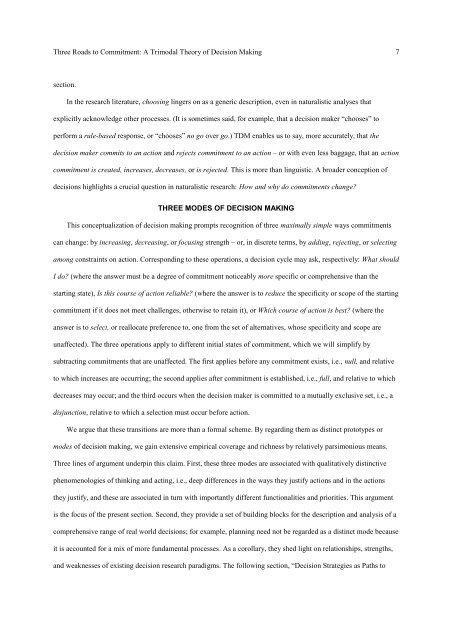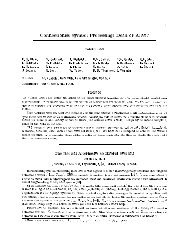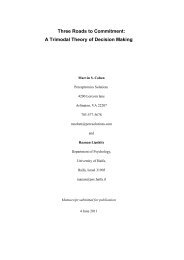Three Roads to Commitment: A Trimodal Theory of Decision Making
Three Roads to Commitment: A Trimodal Theory of Decision Making
Three Roads to Commitment: A Trimodal Theory of Decision Making
Create successful ePaper yourself
Turn your PDF publications into a flip-book with our unique Google optimized e-Paper software.
<strong>Three</strong> <strong>Roads</strong> <strong>to</strong> <strong>Commitment</strong>: A <strong>Trimodal</strong> <strong>Theory</strong> <strong>of</strong> <strong>Decision</strong> <strong>Making</strong> 7<br />
section.<br />
In the research literature, choosing lingers on as a generic description, even in naturalistic analyses that<br />
explicitly acknowledge other processes. (It is sometimes said, for example, that a decision maker “chooses” <strong>to</strong><br />
perform a rule-based response, or “chooses” no go over go.) TDM enables us <strong>to</strong> say, more accurately, that the<br />
decision maker commits <strong>to</strong> an action and rejects commitment <strong>to</strong> an action – or with even less baggage, that an action<br />
commitment is created, increases, decreases, or is rejected. This is more than linguistic. A broader conception <strong>of</strong><br />
decisions highlights a crucial question in naturalistic research: How and why do commitments change<br />
THREE MODES OF DECISION MAKING<br />
This conceptualization <strong>of</strong> decision making prompts recognition <strong>of</strong> three maximally simple ways commitments<br />
can change: by increasing, decreasing, or focusing strength – or, in discrete terms, by adding, rejecting, or selecting<br />
among constraints on action. Corresponding <strong>to</strong> these operations, a decision cycle may ask, respectively: What should<br />
I do (where the answer must be a degree <strong>of</strong> commitment noticeably more specific or comprehensive than the<br />
starting state), Is this course <strong>of</strong> action reliable (where the answer is <strong>to</strong> reduce the specificity or scope <strong>of</strong> the starting<br />
commitment if it does not meet challenges, otherwise <strong>to</strong> retain it), or Which course <strong>of</strong> action is best (where the<br />
answer is <strong>to</strong> select, or reallocate preference <strong>to</strong>, one from the set <strong>of</strong> alternatives, whose specificity and scope are<br />
unaffected). The three operations apply <strong>to</strong> different initial states <strong>of</strong> commitment, which we will simplify by<br />
subtracting commitments that are unaffected. The first applies before any commitment exists, i.e., null, and relative<br />
<strong>to</strong> which increases are occurring; the second applies after commitment is established, i.e., full, and relative <strong>to</strong> which<br />
decreases may occur; and the third occurs when the decision maker is committed <strong>to</strong> a mutually exclusive set, i.e., a<br />
disjunction, relative <strong>to</strong> which a selection must occur before action.<br />
We argue that these transitions are more than a formal scheme. By regarding them as distinct pro<strong>to</strong>types or<br />
modes <strong>of</strong> decision making, we gain extensive empirical coverage and richness by relatively parsimonious means.<br />
<strong>Three</strong> lines <strong>of</strong> argument underpin this claim. First, these three modes are associated with qualitatively distinctive<br />
phenomenologies <strong>of</strong> thinking and acting, i.e., deep differences in the ways they justify actions and in the actions<br />
they justify, and these are associated in turn with importantly different functionalities and priorities. This argument<br />
is the focus <strong>of</strong> the present section. Second, they provide a set <strong>of</strong> building blocks for the description and analysis <strong>of</strong> a<br />
comprehensive range <strong>of</strong> real world decisions; for example, planning need not be regarded as a distinct mode because<br />
it is accounted for a mix <strong>of</strong> more fundamental processes. As a corollary, they shed light on relationships, strengths,<br />
and weaknesses <strong>of</strong> existing decision research paradigms. The following section, “<strong>Decision</strong> Strategies as Paths <strong>to</strong>




